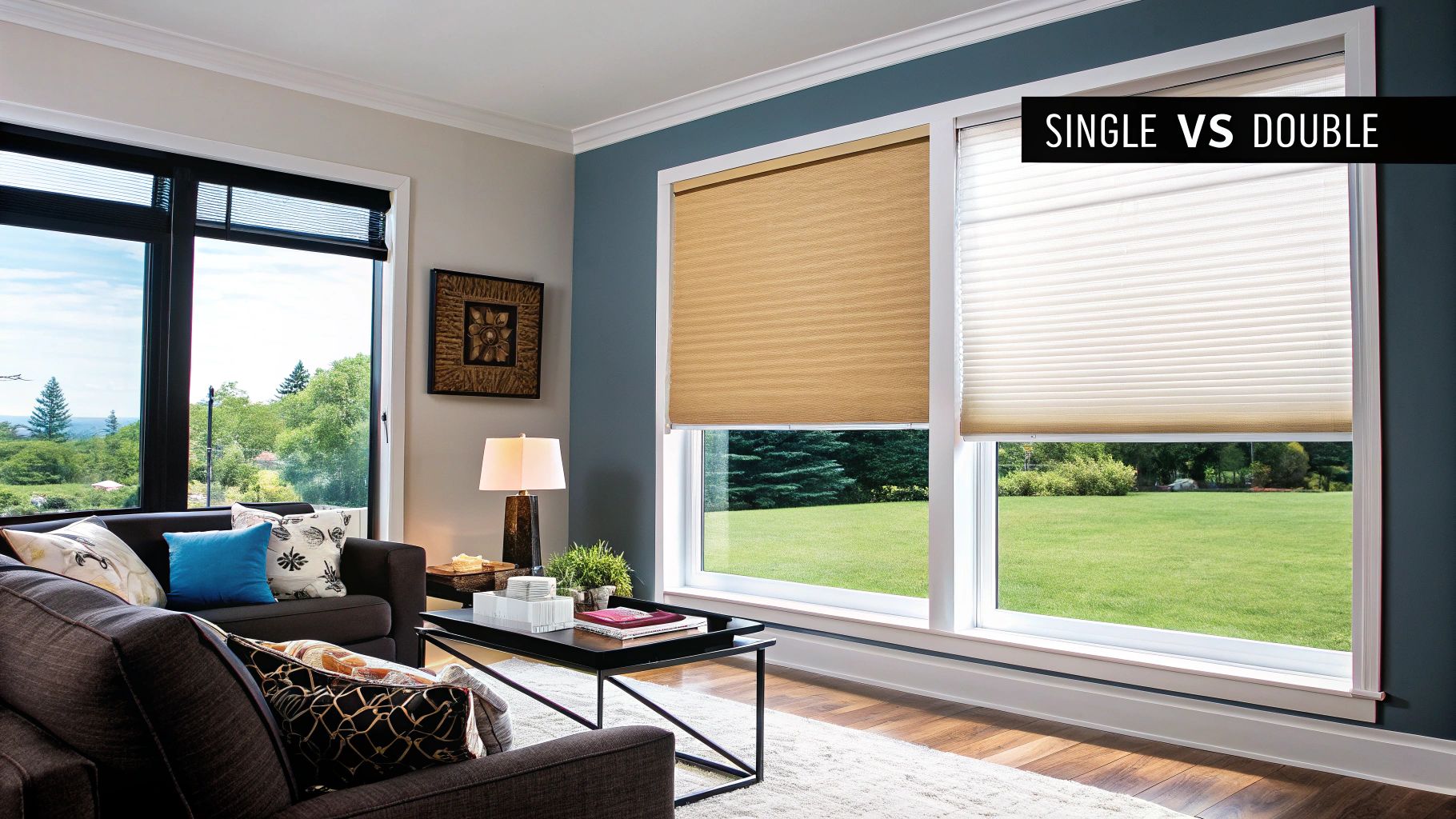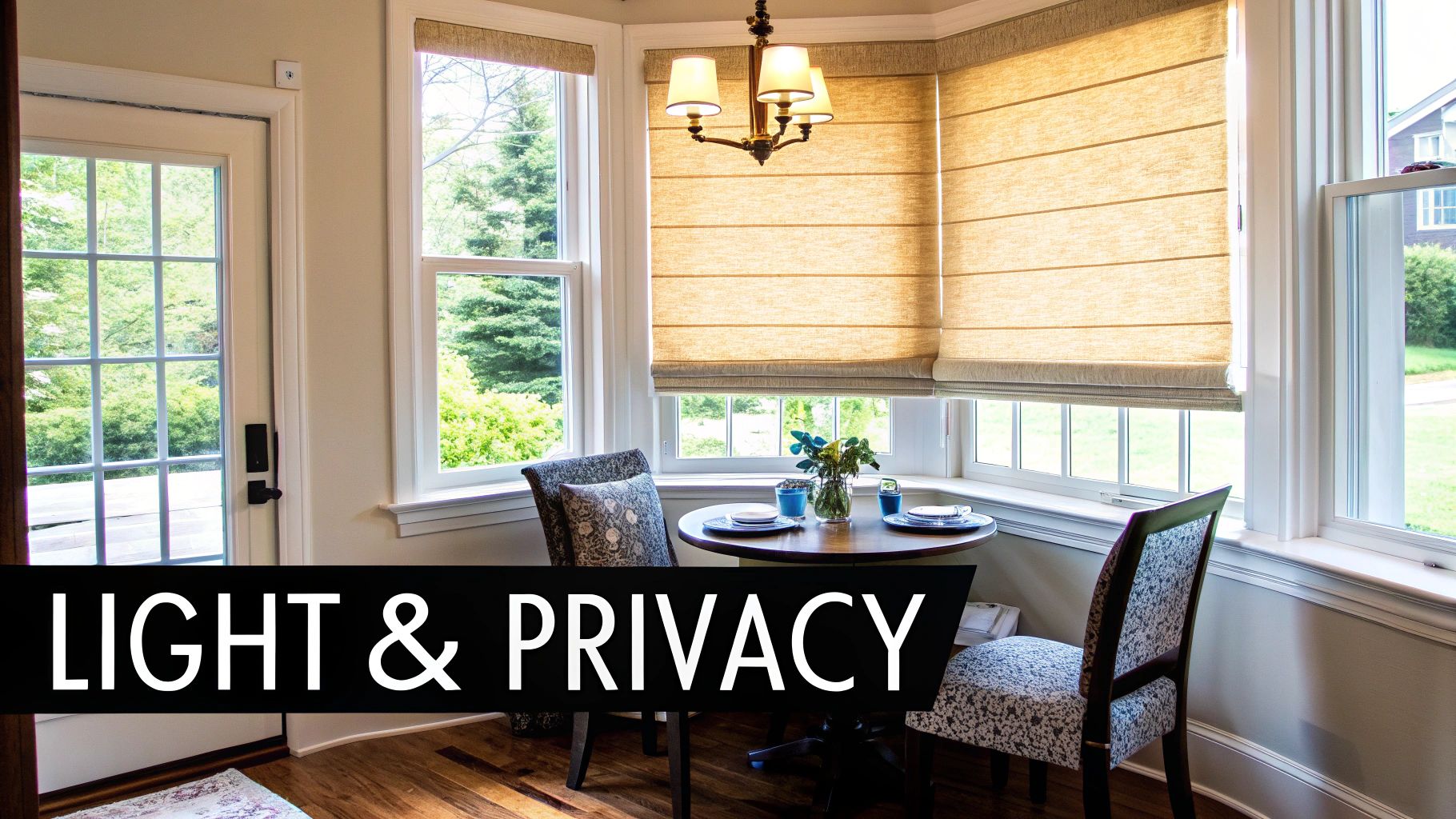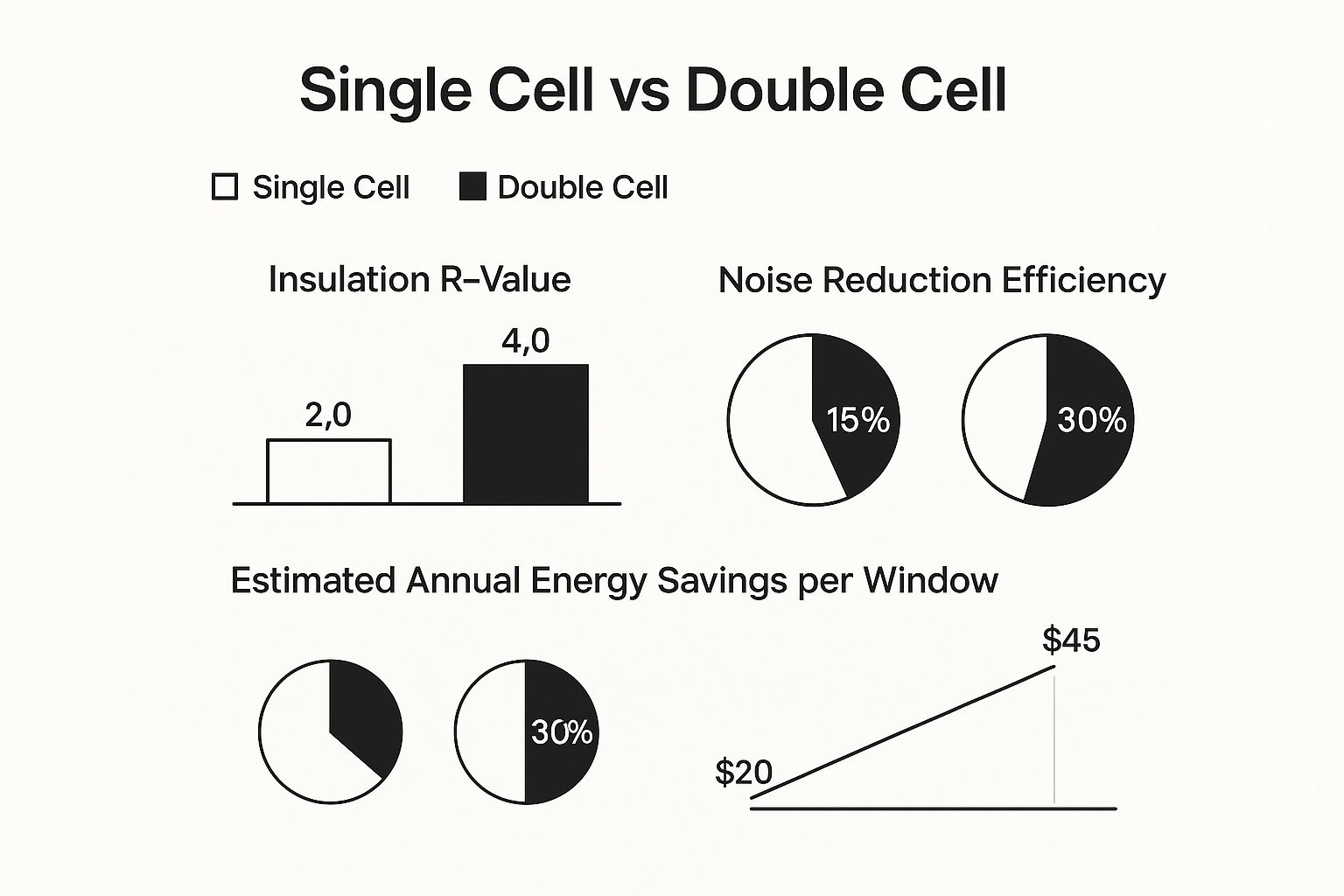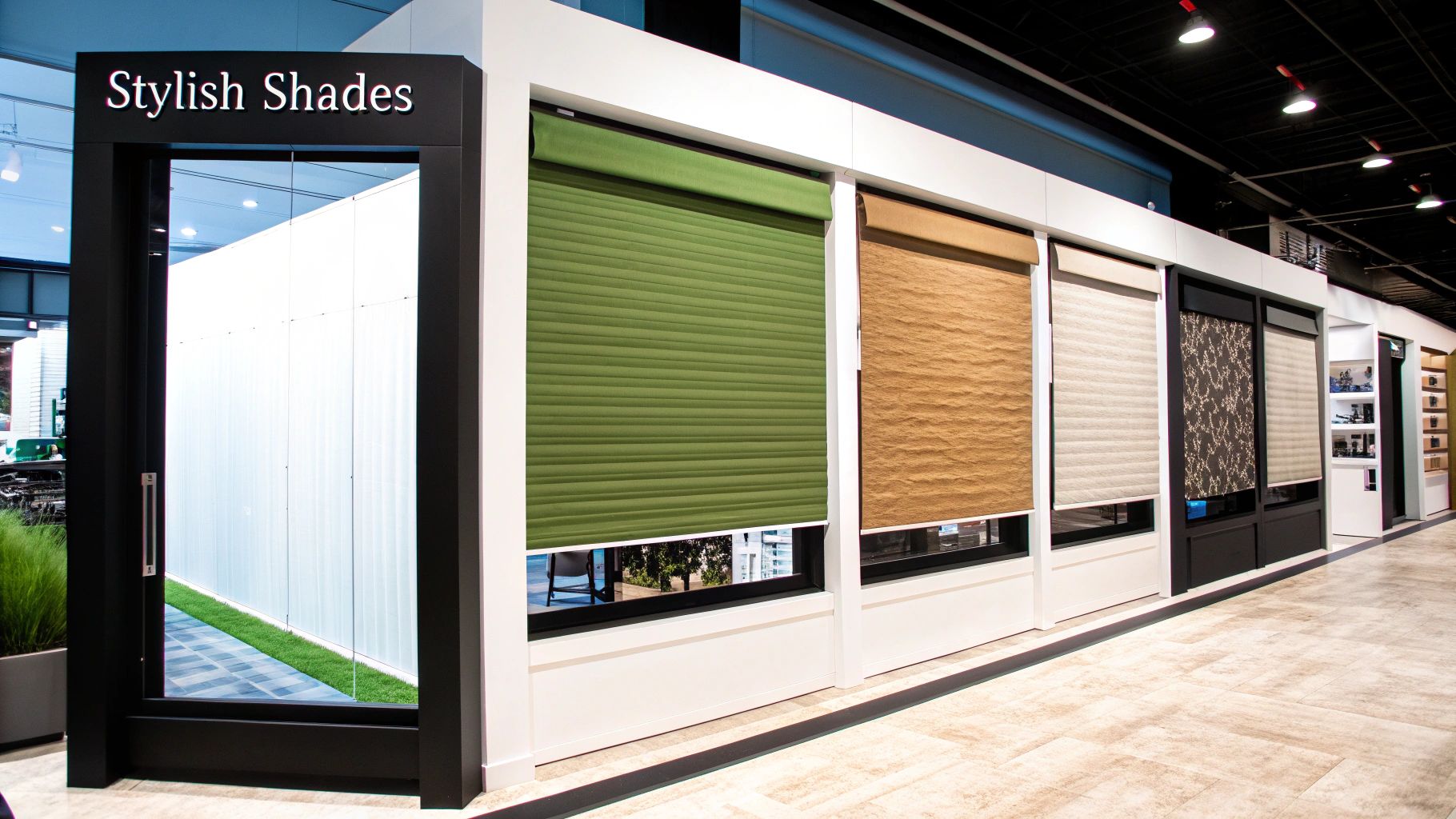Double vs Single Cell Shades: Which Works Best for You?
- Johann Reardon
- Jul 18
- 12 min read
Why This Choice Actually Matters More Than You Think

At Home Blinds & Floors, we often see homeowners treat the choice between single and double cell shades as a simple upgrade decision. But it's so much more than that. This seemingly minor structural difference has a ripple effect, impacting everything from energy savings to the overall feel of your home.
Consider a sun-drenched, west-facing living room. Single cell shades might offer adequate daytime light filtering, keeping the room bright and open. But that intense afternoon sun could still overheat the space, forcing you to rely heavily on air conditioning.
In this case, double cell shades, with their superior insulation, offer better long-term value despite the higher upfront cost. You'll likely see significantly lower energy bills and enjoy a more comfortable living space.
The Growing Importance of Efficiency
This focus on efficiency reflects a larger market trend. The global market for cellular shades is booming, projected to reach USD 5.2 billion by 2030. This growth is fueled by rising consumer awareness of energy efficiency and the demand for sustainable home decor.
Double cell shades currently command roughly 50% of the market share thanks to their superior insulation. For a deeper dive into the expanding cellular shade market, check out this report: Learn More about the Growth of Cellular Shades.
Light Control: A Subtle But Significant Difference
The choice between single and double cell shades also affects light control in subtle but important ways. A home office, for example, might benefit from the streamlined look and light filtering of single cell shades. These maximize natural light while minimizing glare on screens.
A bedroom, on the other hand, requires a different approach. The enhanced light-blocking of double cell shades creates a darker, more restful sleep environment. At Home Blinds & Floors, we specialize in helping homeowners in [Your City] navigate these nuances. We offer personalized consultations to find the perfect solution for every room. We believe in finding the right window treatment to match each home's unique needs and lifestyle.
What Your Windows Actually Need: Construction Secrets Revealed

Forget the marketing hype about air pockets in cellular shades. Think of them as carefully engineered features designed to solve specific window covering problems. At Home Blinds & Floors, our years of experience working with both single and double cell constructions have shown us how small design differences lead to big performance changes.
Single cell shades aren't just "cheaper" alternatives to double cell options. They truly shine in situations where their lighter weight and slimmer profile are beneficial. Double cell construction isn’t always better; it’s specifically designed to address thermal issues that may not be a concern in every home.
Consider a kitchen window, for example. The streamlined design of a single cell shade from Home Blinds & Floors might be the perfect solution, providing adequate light filtering and privacy without feeling bulky. But for a bedroom window, the enhanced light-blocking and insulation of a double cell shade could be better for a good night’s sleep. The best choice always depends on the specific room and its purpose.
Cell Size and Light Diffusion: A Deeper Look
Cell size and structure affect more than just insulation. They also have a major impact on how light spreads throughout the room. Single cell shades often create a softer, more diffused light, while double cell shades offer a wider range of light control, from light filtering to almost complete blackout. Understanding this relationship between cell structure and light diffusion is key to picking the right shades.
Manufacturing quality also plays a critical role, and it differs significantly between brands. Companies like Hunter Douglas and Springs Window Fashions have long been leaders in cellular shade innovation. For a deeper dive into options from a top brand, check out their comparison guide: Discover more insights about single vs. double cell shades.. Construction quality impacts not only how long your shades last, but also how well they insulate and control light. This is where working with a reputable provider like Home Blinds & Floors makes a real difference.
Durability: Separating Fact from Fiction
While some manufacturers rely on marketing buzzwords, true durability comes down to the materials and construction techniques used. Because of their structure, double cell shades tend to be more resistant to wear and tear than single cell options. However, high-quality single cell shades made with premium materials can also last for years. For more information on selecting window treatments, take a look at this guide: How to Choose Window Treatments: Expert Tips for Every Room. Ultimately, choosing between single and double cell shades means carefully evaluating your particular needs and budget. Home Blinds & Floors is dedicated to offering personalized guidance to homeowners in [Your City], helping them find the perfect window treatments for their individual homes.
The Energy Story Nobody Tells You About
Forget the simplistic notion that double cell shades are always the superior energy saver. At Home Blinds & Floors, our years of experience conducting energy audits and observing real-world performance have taught us a more nuanced truth. Single cell shades can sometimes outperform their double cell counterparts, particularly in moderate climates. The key lies in understanding the interplay between climate, window orientation, and the unique characteristics of your home.
A west-facing window in a desert climate presents a vastly different challenge than a north-facing window in a milder region. The intense afternoon sun beating down on a west-facing window necessitates superior insulation, making double cell shades the clear winner in that scenario. However, a north-facing window might not experience such dramatic temperature fluctuations. In this case, single cell shades can offer adequate insulation while maintaining a sleeker, more streamlined appearance.

This infographic illustrates the R-value, noise reduction, and estimated annual energy savings for both single and double cell shades. Double cell shades generally offer twice the insulation (R-4.0 vs. R-2.0) and noise reduction (30% vs. 15%), potentially resulting in higher annual energy savings per window ($45 vs. $20). Keep in mind that these are estimates. Your actual savings will depend on factors specific to your home.
To illustrate the real-world differences, let's consider a few home scenarios:
To understand these nuances and determine the ideal solution for your specific needs, a professional consultation with Home Blinds & Floors is highly recommended.
The table above highlights how the "best" choice depends entirely on your individual circumstances.
Considering Aesthetics and HVAC Efficiency
Beyond energy savings, consider the aesthetic impact. Window treatments play a significant role in your home's overall design. Exploring home decor gifts can provide further inspiration for elevating your space. Additionally, your HVAC system's efficiency plays a role. A high-efficiency system might not benefit as dramatically from the extra insulation of double cell shades as an older system would. For a deeper dive into energy-efficient window treatment options, explore our guide: Uncover the Secret to Cozy Energy Efficiency: 5 Window Treatments That Will Blow Your Mind.
Ultimately, the energy efficiency story isn't a one-size-fits-all narrative. It's about understanding your particular needs and selecting the option that optimizes both comfort and energy efficiency within your home.
Light Control That Actually Works for Real Life
Light management isn't about achieving total darkness. It's about harnessing natural light to create comfortable and functional living spaces. Years of experience at Home Blinds & Floors have given us a keen understanding of how different cellular shade constructions address specific lighting needs. When considering your options, remember that other building materials, like roofing, also contribute to energy efficiency. Exploring resources like ENERGY STAR qualified roofing products can be valuable. The single layer of fabric in single cell shades diffuses light differently than the double layer in double cell shades. This seemingly small difference significantly impacts everything from screen glare to furniture protection. It becomes especially important in rooms where lighting needs change throughout the day.
From Glare Reduction to Ambient Lighting
Imagine a home office bathed in morning sun. Natural light is desirable, but direct glare on a computer screen can make work difficult. Single cell shades, especially with light-filtering fabrics, soften incoming light, reducing glare while keeping the room bright and airy. However, for a west-facing home office dealing with intense afternoon sun, the added insulation and light-blocking power of double cell shades might be necessary for comfort and energy savings. At Home Blinds & Floors, our wide selection of both single and double cell shades allows us to tailor solutions for your unique needs in [Your City].
Bedrooms require different levels of light control throughout the day. Soft, diffused light might be perfect for daytime reading, while complete darkness is essential for sleep. Double cell shades excel at creating a dark sleep environment due to their superior light-blocking properties. The added privacy they offer is another benefit for many homeowners.
Balancing Light and Privacy in Living Spaces
Living rooms and family rooms present unique challenges. These spaces often require a balance of natural light during the day and privacy in the evening. Single cell shades can provide adequate daytime light filtering and privacy, while double cell shades offer stronger light blocking for movie nights or when privacy is a priority. The best choice truly depends on your lifestyle. Personalized consultations with Home Blinds & Floors can help you navigate these decisions, ensuring you select the ideal shades for your home.
The Impact of Cell Structure on UV Protection
Beyond light control, cell structure impacts UV protection. Both single and double cell shades offer some UV blocking, but the extra layer of fabric in double cell shades generally provides superior protection. This is crucial for preserving furniture, flooring, and artwork from sun damage, a significant consideration, particularly in sunny climates. Home Blinds & Floors provides a variety of fabrics with varying degrees of UV protection, allowing us to further customize your window treatments. Our family-owned business is committed to serving homeowners throughout the Delmarva Peninsula with exceptional products and service.
The Real Cost Analysis Everyone Should Know

At Home Blinds & Floors, we guide homeowners on Delmarva through the sometimes perplexing world of window treatments. We go beyond just discussing style; we dive deep into the long-term value. One key area we focus on is understanding the real cost comparison between single and double cell shades. It's about more than just the initial price tag.
Many people focus on the upfront cost difference, but that's just one piece of the puzzle. Factors like installation, upkeep, and potential energy savings significantly impact the overall investment. Double cell shades, while typically a larger initial expense, often bring significant energy savings over time, potentially making them a more cost-effective choice in the long run.
Window Size and Pricing Tiers
The size of your windows greatly influences the final price for both single and double cell shades. Larger windows naturally require more materials, driving up the cost of both options. The difference in price between single and double cell shades becomes even more noticeable with larger windows. To provide accurate pricing, we offer free in-home consultations. Our experts will precisely measure your windows and offer a personalized quote, ensuring you get the best possible value.
Custom Features and Investment Justification
Adding custom features, such as motorized lifts or specialty fabrics, enhances both functionality and cost. While these additions offer clear benefits, it's important to consider your budget. Motorized shades, for instance, offer exceptional convenience, especially for high or hard-to-reach windows. This benefit might justify the additional cost for some. We offer a wide selection of customization options at Home Blinds & Floors so you can create the perfect window treatments for your specific needs and style.
Energy Savings Across Climate Zones: A Long-Term Perspective
The climate you live in significantly impacts the potential energy savings from cellular shades. In regions with extreme temperatures – whether very hot or very cold – double cell shades provide significantly better insulation, leading to greater energy savings. In more temperate climates, single cell shades may provide adequate insulation. For more detailed information on energy-efficient window treatments, check out our guide: The Comprehensive Guide to Energy-Efficient Window Treatments Across All Seasons. We at Home Blinds & Floors can assess your home's energy needs and recommend the most effective window treatment solutions. We're dedicated to providing cost-effective and energy-saving options for all our clients.
To help illustrate the long-term cost differences, let’s look at a sample five-year cost analysis. This table incorporates estimated purchase prices, installation, potential energy savings, and other value considerations.
Five-Year Value Analysis: Single vs Double Cell Investment
*Break-even timeline based on estimated energy savings. Actual results may vary.
As you can see, while the initial cost of double cell shades is higher, the increased energy savings can lead to a lower total cost over time. The specific break-even point depends on factors like your climate, window size, and energy usage habits. Consulting with one of our experts at Home Blinds & Floors can help you determine the best long-term investment for your home.
Matching Cellular Shades to Your Specific Situation
Choosing between single and double cell shades isn't about one being inherently "better." It's about finding the perfect match for your home and lifestyle. At Home Blinds & Floors, we understand that every home on the Delmarva Peninsula has unique needs, from a sprawling ranch to a cozy Victorian. A young family’s priorities will differ from those of empty nesters, and we tailor our recommendations accordingly.
Architectural Style and Shade Selection
Your home’s architecture plays a key role in choosing the right cellular shade. Homes with expansive windows and open floor plans often benefit from the superior insulation of double cell shades, helping maintain comfortable temperatures and minimizing energy loss. Smaller homes or those with fewer windows may find single cell shades perfectly sufficient for their insulation needs.
Think about a historic Victorian, with its ornate details and charm. Bulky window treatments can detract from these features. Single cell shades offer a slimmer profile, preserving the home’s architectural integrity while still providing effective light control.
Navigating Challenging Installations
Some windows simply aren't standard. Awkward shapes or unusual sizes can present installation challenges. Single cell shades, with their lighter weight and greater flexibility, are often a good solution in these situations. They can also be easier on mounting hardware, particularly in situations where heavier double cell shades might cause strain.
For those hard-to-reach windows, consider motorized shades. Available for both single and double cell constructions, motorized shades offer a convenient way to adjust light and privacy without manual operation.
Balancing Aesthetics with Practicality
Your personal style is just as important as practical considerations. Double cell shades have a slightly more substantial look, adding a touch of warmth and coziness. Single cell shades, on the other hand, have a sleeker, more streamlined appearance that often complements modern or minimalist décor. You might be interested in exploring eco-friendly blinds for a sustainable design choice.
Cost is always a factor. When budgeting for new shades, it's helpful to understand the larger market context, much like researching faucet installation cost. The blinds and shades market is projected to reach USD 9.11 billion by 2032. Cellular shades are a significant part of this growth. North America represents a substantial portion of this market, highlighting the increasing demand for effective window treatments. Discover more insights about the blinds and shades market.
At Home Blinds & Floors, we offer personalized consultations. We take the time to understand your lifestyle, budget, and the specifics of your home to recommend the best solutions. We’re dedicated to providing quality products and exceptional service to homeowners throughout the Delmarva Peninsula.
Your Decision Framework and Next Steps
Choosing between single and double cell shades isn't a simple matter of one being "better" than the other. It's about understanding your specific needs and how each type of shade addresses those needs. Let's break down a practical decision framework to help you navigate this choice.
Assessing Your Home's Needs
Start by considering the orientation of your windows. East-facing windows catch the morning sun, while west-facing windows bear the brunt of the afternoon heat. How much direct sunlight enters your rooms plays a significant role in determining the right shade. Are you primarily concerned with energy savings, light control, or perhaps minimizing outside noise? These are key questions to ask. For example, in hotter climates, single cell shades from Home Blinds & Floors might suffice. But if you live in a colder region, the extra insulation of double cell shades could be a worthwhile investment.
Think about the purpose of each room, too. A bedroom designed for maximum darkness benefits from the light-blocking capabilities of double cell shades. A living room where natural light is prized might be better suited to single cell shades. For enhanced home security, you might even consider motorized blinds: Unveiling the Hidden Benefits of Motorized Blinds for Home Security Enhancement. The ideal solution truly depends on the specific application.
Prioritizing Your Requirements
Once you've assessed your home's needs, prioritize what matters most. Is maximizing energy efficiency your top priority, or is budget the main driver? Double cell shades offer superior energy savings, but they do come with a higher price tag. Single cell shades provide excellent value, especially for those working within a stricter budget. Home Blinds & Floors offer a wide selection of cellular shades at competitive prices, helping you find the right balance between performance and affordability. A personalized consultation can help you weigh these factors and focus on the features that truly matter to you.
Expert Consultation and Professional Installation
Regardless of whether you choose the streamlined look of single cell shades or the enhanced insulation of double cell shades, professional installation is key. Accurate measurements are essential for a perfect fit, ensuring you get the most out of your shades in terms of both energy efficiency and light control. Home Blinds & Floors provides expert consultation and professional installation services. As a family-owned business serving the Delmarva Peninsula, they're committed to personalized service from the initial consultation to the final installation. Schedule a free consultation to explore your options and find the ideal window treatment solution for your home: Explore Window Treatment Solutions with Home Blinds & Floors.

.avif)